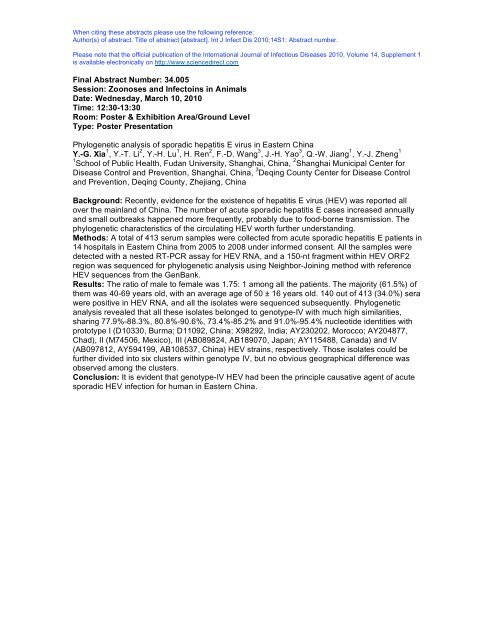14th ICID - Poster Abstracts - International Society for Infectious ...
14th ICID - Poster Abstracts - International Society for Infectious ...
14th ICID - Poster Abstracts - International Society for Infectious ...
Create successful ePaper yourself
Turn your PDF publications into a flip-book with our unique Google optimized e-Paper software.
When citing these abstracts please use the following reference:<br />
Author(s) of abstract. Title of abstract [abstract]. Int J Infect Dis 2010;14S1: Abstract number.<br />
Please note that the official publication of the <strong>International</strong> Journal of <strong>Infectious</strong> Diseases 2010, Volume 14, Supplement 1<br />
is available electronically on http://www.sciencedirect.com<br />
Final Abstract Number: 34.005<br />
Session: Zoonoses and Infectoins in Animals<br />
Date: Wednesday, March 10, 2010<br />
Time: 12:30-13:30<br />
Room: <strong>Poster</strong> & Exhibition Area/Ground Level<br />
Type: <strong>Poster</strong> Presentation<br />
Phylogenetic analysis of sporadic hepatitis E virus in Eastern China<br />
Y.-G. Xia 1 , Y.-T. Li 2 , Y.-H. Lu 1 , H. Ren 2 , F.-D. Wang 3 , J.-H. Yao 3 , Q.-W. Jiang 1 , Y.-J. Zheng 1<br />
1 School of Public Health, Fudan University, Shanghai, China, 2 Shanghai Municipal Center <strong>for</strong><br />
Disease Control and Prevention, Shanghai, China, 3 Deqing County Center <strong>for</strong> Disease Control<br />
and Prevention, Deqing County, Zhejiang, China<br />
Background: Recently, evidence <strong>for</strong> the existence of hepatitis E virus (HEV) was reported all<br />
over the mainland of China. The number of acute sporadic hepatitis E cases increased annually<br />
and small outbreaks happened more frequently, probably due to food-borne transmission. The<br />
phylogenetic characteristics of the circulating HEV worth further understanding.<br />
Methods: A total of 413 serum samples were collected from acute sporadic hepatitis E patients in<br />
14 hospitals in Eastern China from 2005 to 2008 under in<strong>for</strong>med consent. All the samples were<br />
detected with a nested RT-PCR assay <strong>for</strong> HEV RNA, and a 150-nt fragment within HEV ORF2<br />
region was sequenced <strong>for</strong> phylogenetic analysis using Neighbor-Joining method with reference<br />
HEV sequences from the GenBank.<br />
Results: The ratio of male to female was 1.75: 1 among all the patients. The majority (61.5%) of<br />
them was 40-69 years old, with an average age of 50 ± 16 years old. 140 out of 413 (34.0%) sera<br />
were positive in HEV RNA, and all the isolates were sequenced subsequently. Phylogenetic<br />
analysis revealed that all these isolates belonged to genotype-IV with much high similarities,<br />
sharing 77.9%-88.3%, 80.8%-90.6%, 73.4%-85.2% and 91.0%-95.4% nucleotide identities with<br />
prototype I (D10330, Burma; D11092, China; X98292, India; AY230202, Morocco; AY204877,<br />
Chad), II (M74506, Mexico), III (AB089824, AB189070, Japan; AY115488, Canada) and IV<br />
(AB097812, AY594199, AB108537, China) HEV strains, respectively. Those isolates could be<br />
further divided into six clusters within genotype IV, but no obvious geographical difference was<br />
observed among the clusters.<br />
Conclusion: It is evident that genotype-IV HEV had been the principle causative agent of acute<br />
sporadic HEV infection <strong>for</strong> human in Eastern China.
















